Skin Tone Test
Skin undertone can be warm, cool or neutral and can be seen beneath the surface of the skin. Although the surface tone of the skin changes depending on exposure to sunlight and skin problems such as rosacea or blackheads, the skin tone remains the same.
If you know your skin tone is warm, cool, or neutral, then you can accurately match your foundation to your skin tone. When foundation doesn't match your skin tone, it appears orange, pink, or ashy. If you bought a foundation that seemed like the right color for you, but it looks weird when applied to your skin, then you've probably misdiagnosed your skin tone.

There are several ways to determine your skin tone, among which the simplest and fastest methods are the following:

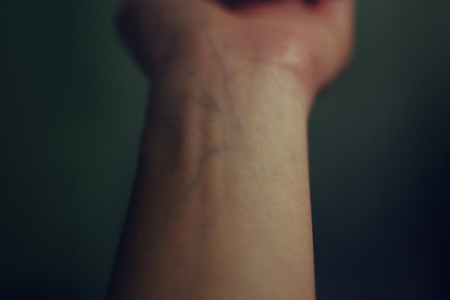
Olive skin tones appear a little grayish or ashy, this comes from a combination of the skin's natural yellowish undertone with the greenish tone that is characteristic of olive skin. For these people, neutral tones in makeup are ideal, although you can experiment with warm shades to find a middle ground. Cool tones in makeup will make olive skin look dull and dirty brown.
Neutral skin tones are those that do not have any obvious undertones of olive, yellowish or Pink colour. People with this skin tone have the easiest time choosing a foundation.  , concealer and powder. If you have a neutral skin tone, then you can use a foundation of several tones at once.
, concealer and powder. If you have a neutral skin tone, then you can use a foundation of several tones at once.
How to determine your skin tone
- What color are your veins? Look at the inside of your wrist. What color are your veins in this area - bluish or greenish? If they have a bluish or purple tint, then you have a cool skin tone. If your veins are greenish in color, then you have a warm skin tone. If you cannot accurately determine the color of your veins, then most likely your skin tone is neutral.
- What colors do you look best in? Are there any colors that make you look better? If colors like blue, purple and emerald green suit you best, then your skin tone is cool. If your favorite colors are red, orange, yellow and olive green, then you have a warm skin tone. And those lucky ones who look beautiful in any color have a neutral skin tone.
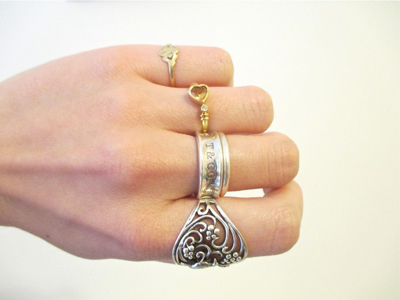
- Do you prefer silver or gold? If gold suits you better, then your skin tone is warm. Those who are more suited to silver have cool skin tones. If both metals suit you equally, then you certainly have a neutral skin tone.
- What color are your eyes and hair? If you have blue, gray or green eyes and light, dark brown or platinum black hair, you most likely have a cool skin tone. Those with brown, amber, or light brown eyes and reddish blond, golden brown, or black hair with golden highlights have a warm skin tone.
You can also do the following test. Take a simple sheet of white paper and hold it to your face. Determine whether your skin color looks dull or good. If it appears dull against a white sheet of paper, then your skin tone is warm. If your skin looks good against white paper, then you have a cool skin tone. If you can't answer this question accurately, then you have a neutral skin tone.
You can also ask your friend to see what color the skin behind your ear is. If it is yellowish, then your skin tone is warm, if it is pink, then you have a cool skin tone. If your friend finds it difficult to answer, then your tone is neutral.

Which celebrities do you associate yourself with? Thus, Scarlett Johansson, Anne Hathaway, Demi Moore, Courteney Cox, Sandra Bullock, Jennifer Hudson and Amanda Seyfried have cool skin tones. Nicole Kidman, Jennifer Lopez, Beyoncé, Jessica Alba, Kate Hudson and Kim Kardashian have warm tone skin.
Once you decide on your skin tone, you can choose your foundation, powder and concealer without any problems. So, the warm shades of these cosmetics usually labeled as beige, golden, tan, caramel or chestnut. Cool shades are porcelain, pink, sable and cocoa. Neutral shades include ivory, dark yellow, nude and praline.
Choosing clothing colors for different skin tones
- Red-haired women with fair skin tones, like Susan Sarandon, Nicole Kidman and Julianne Moore, look best with coral, orange-yellow, brown, bronze and other earthy colors.
- Blondes with fair skin, such as Gwyneth Paltrow, Emma Stone and Kirsten Dunst, look very good in all shades of pink.
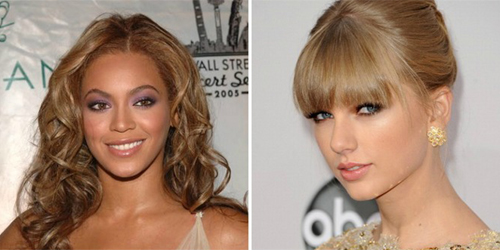
- Brunettes with fair skin tones, such as Julia Roberts and Jennifer Garner, look good in light pink and soft red shades.
- Women with dark hair and fair skin tones, such as Demi Moore, Sandra Bullock and Penelope Cruz, will look better in brighter shades of pink and cherry.
- Those with black hair and dark skin tones like Halle Berry and Oprah Winfrey look great in more neutral shades like nude pink, light brown and coral.
Learning more about your skin is the task of every girl. Why is this so important, you ask?!
I answer, everything is very simple, knowing your color, you can easily choose the right foundation, choose the right hair color, evaluate yours, choose the right things in color. Let's take a little test to find out your skin tone.
But first, it should be noted that makeup artists distinguish between 7 main skin tones. Namely:
Very pale skin, - pale skin, - medium tone, - olive tone, - dark skin, - tanned skin, - dark tone.
In addition to the main skin tones, there are also subtones.
This means that, regardless of skin tone, it may be dominated by:
warm undertone,
cold undertone,
or neutral (very rare).
Warm shade- This is skin in which a yellowish tint dominates. It can be either light skin or dark skin. 
Cool shade- This is skin in which a bluish or pink tint dominates. 
Neutral is a rare skin tone that is hard to define as it has all three pigments in its undertones.
It has been found that most Eastern women have warm undertones. Western women, on the contrary, have skin in which a cool tone predominates. Spaniards, Greeks and Italians generally have warm skin tones, while Russians, Americans, Germans and Norwegians have cool skin tones.
And so we move on to the test.
Step 1. Check the veins.
We carefully evaluate our veins (for example, on the wrist)
Green veins (warm tone)
Blue veins (cold tone)
Both blue and green (neutral)
 Step 2. Use a piece of paper
Step 2. Use a piece of paper
Hair color, jewelry, makeup, clothing glow, all affect skin color. This is why it is sometimes very difficult to evaluate your natural color. Get ready for the next test. Wear something nude, pull your hair back, and of course take off your makeup. Then take pure white paper, A4 size, and apply it to your face. It is advisable to do all this in daylight. Thus, it will become clear to you which pigment is dominant, warm or cold. Tested to work!
Step 3: Decoration test.
Prepare for the test - stock up on gold and silver jewelry. Jewelry of these shades is also suitable.
If gold jewelry matches your skin best, you have warm skin. You can notice that it is Asian and Indian women who like to decorate themselves with this metal.
If your skin appears more vibrant, then when you apply silver, white gold or platinum, you have a cool skin tone. White metal is most often chosen by European women.
Neutral skin approach is everything. That's lucky!! 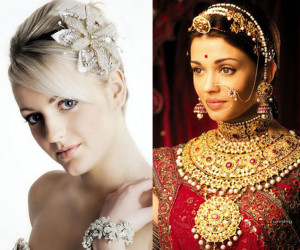
Step 4: Fabric Test
Take a new (or bleached) white fabric and an old white fabric (it is no longer completely white, but greyish). Throw it one at a time over your shoulders, close to your face, and see which color works best with you. If your face becomes brighter with a snow-white fabric, it means you have a cool undertone. If the off-white fabric suits you, you have a warm undertone. White color always refreshes the skin, but it makes warm skin dull.
It's very simple, you need to evaluate the color of the skin behind the ears. You may need help passing this test. Ask someone to see what color the skin behind your ears is. If it is pinkish or bluish, you have a cold tone. if the code is pale or yellow - warm.
Once you find out which subtone dominates your appearance, you can easily determine your color type and make a decision. Knowing your color type will help you choose the right not only cosmetics, but also clothes.
“Tell me, my little mirror, and tell me the whole truth, am I the sweetest, most ruddy and whitest in the world?” - how many real modern beauties would hear an affirmative answer?
Immediately after waking up, without water procedures, a cup of invigorating coffee and applying makeup, only movie heroines glow with charm. In order for an ordinary young lady to get closer to her cherished ideal, she must at least “paint her own face.”
The key to neat makeup is uniform skin color created by foundation.
The cosmetics industry of the last decade has given women a lot of all kinds of products to even out their complexion. These innovative products perform many functions and meet the needs of even the most demanding girl.
However, the abundance of assortment does not help to decide main problem: how to choose a foundation to match your skin color.
To solve this problem, it is necessary to understand the color type, i.e. facial skin tone.
Professional makeup artists have identified three main skin types:
- neutral;
- cold;
- warm.
Pure types are defined by the following characteristics:
- Cold- the color of the veins on the wrist is bluish or purple; skin color in natural light with a bluish tint. The preferred metal for jewelry is silver;
- Warm— the color of the veins on the wrist is olive or khaki; skin color in natural light with a yellowish tint. The preferred metal for jewelry is gold;
- Neutral- the color of the veins on the wrist is blue-green; skin color in natural light with a green tint in the sun. The preferred metal for jewelry is any.
In addition to the obvious types, there are mixed variants.
When choosing a foundation, the color type is not the only point you should rely on.
One of the secrets of choosing the right cream to even out the color of the skin is a clear definition of another nuance.
Depending on the reaction to the sun, the epidermis is divided into red and yellow.
If the tan goes on easily and evenly, then the woman has a yellow skin class. The red class is characterized by a sharp reaction to ultraviolet radiation, expressed by redness and a copper tint of tan.
How to choose a foundation to match your skin color: basic rules
The selection of foundation should be given special attention. Evening out the complexion and camouflaging defects is the most important and responsible stage of makeup. If the tone is chosen correctly and the cream is applied skillfully, then minimal manipulations with the eyes and lips are often sufficient to create a beautiful image.
Otherwise, the girl faces the problem of “aging makeup”, when the face looks much older than its real age, or with a “mask effect”, when the foundation creates a lifeless, alien cover on the face.
 To find out how to choose a foundation that matches your color, you should first determine your color type and skin type in general. And based on this, listen to the advice of makeup artists.
To find out how to choose a foundation that matches your color, you should first determine your color type and skin type in general. And based on this, listen to the advice of makeup artists. - With skin belonging to the red type, cream options such as pink beige, apricot or copper are in harmony - those that have scarlet notes at the base.
- For owners of the yellow type, experts insist that they choose from foundation creams in shades such as light beige, gold, walnut, and sand.
- When going to the store for foundation, it is optimal to choose a clear sunny day so that you can evaluate the product in natural sunlight.
- Experts recommend that, even if the room is very light, before purchasing, go outside and check the shade of the product again.
- Foundation must be applied to well-cleansed skin, so you should not select a toner without washing your face.
- Cosmetologists advise on the eve of a responsible choice to carry out a home exfoliation procedure, remove dead cells, apply a moisturizer, then the skin will be maximally prepared for the selection of foundation.
- Testing cream on the wrist is the most common mistake. The color of the skin on the face and hand is significantly different. The shade of the wrist serves only as a hint in determining the color type.
- The test product in the store should be applied to the cheek, this is the only way to assess its suitability.
- Professional makeup artists practice using several colors of foundation in one makeup, for example, the main tone and a lighter shade in the eye area, and a darker product on the nose and along the contour of the face.
Note! Choose a foundation to match your color problem skin, in case of significant defects on the face (acne, pimples, scars or red veins), testing of the product in the area behind the ear is possible - there the skin most closely matches the complexion.
How to do this is the second point; it is better to resort to the help of a trusted friend.
There are no fashion trends or popular shades when choosing a foundation. This the product is selected strictly based on external data, for each specific skin type.
Color palette for fair skin
Fair skin is often called porcelain for its noble pale shade, similar to the cheeks of sophisticated dolls. 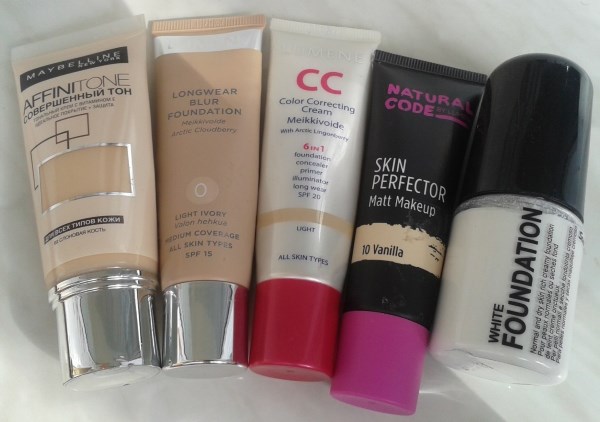
A tip to help you choose a foundation that matches your skin color is to study the names of the shades. The most suitable products are labeled “light” and “transparent”.
Pale skin is characterized by some soreness and dullness, therefore Makeup artists recommend foundations with a subtle peach tint, then your facial skin will be fresher and healthier.
The main secret on how to choose the right foundation that suits a specific shade is to test three similar tones on your face and determine the one that matches your skin color.
When there is a difficulty which of two shades to give preference to, experts advise choosing the lighter one.
Those with pale skin often plan to give their faces a tan effect with foundation - this is a serious mistake that leads to unnatural makeup. The tone should be as close to natural as possible. Other cosmetics are used to obtain a tan.
Color scheme for gray, earthy skin
Industrial cities have not had a favorable environmental situation for a long time. Smoke, smog, constant stress and rare exposure to fresh air lead to the fact that even the most enviable beauties complain about a sallow complexion. This skin looks gray, tired and aged. 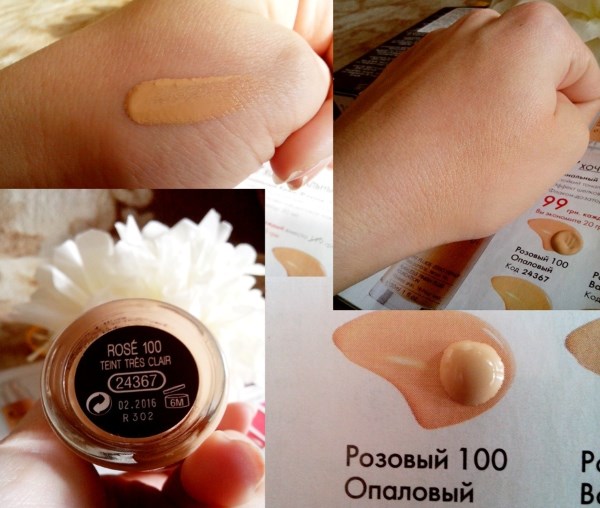
With careful selection of the cream, this problem can also be solved. For a fresh face cosmetologists advise using foundations with a pinkish-brown tint.
Foundation tone if skin is prone to redness
Due to the proximity of capillary vessels, even healthy epidermis, without blackheads and acne, may have a reddish tint. More often a clear red tone of the skin stands out in the nasolabial area. A good foundation can even out this deficiency and provide uniform, long-lasting beautiful makeup.
To disguise skin prone to redness, foundations with a light green tint are used. Cool shades are most acceptable.
And here pink color scheme is a clear exception from suitable foundations for this skin type. 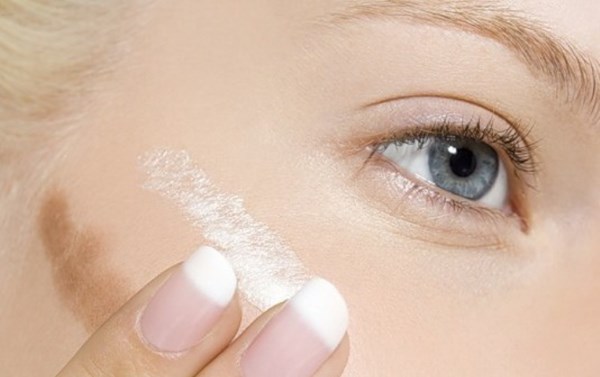
Foundation shades for dark skin
The most matching colors for owners dark skin– nuances of chocolate or caramel.
In general, women with dark skin are naturally lucky and need minimal amount toning agent.
If the choice is between two similar shades, then in this case You should give preference to a darker cream. 
How to choose foundation for evening makeup
On festive event, when exiting secular society or a romantic dinner for two, a woman wants to look especially charming. To create a charming image, you will definitely need long-lasting, carefully executed makeup.
There are a couple of nuances when choosing a foundation for an evening event:

When a photo shoot is planned at an evening event and you want to look beautiful both in person and in photographs, then it is extremely foundations with reflective particles should be used with caution, which stand out as white spots on the face when cameras flash.
In general, if light foundations are suitable for daytime makeup, then for an evening out it is better to use thick creams, maximally leveling the surface of the face.
Newbie mistakes when choosing foundation to match your skin color
Despite numerous recommendations from specialists, a lot of master classes from leading makeup artists, there are girls with clearly incorrect makeup. At best, the foundation does not emphasize their beauty, but more often than not it looks comical and even scary.
In order not to be considered a novice in the art of make-up, it is important to know how to choose a foundation that matches your skin color in order to avoid mistakes.
This way, you will protect yourself in advance from mocking glances because of your stupid and inappropriate makeup. 
The list of common errors includes:
- selection of tone, based only on the indicator given on the package;
- using the tester on the wrist or back of the hand;
- choosing a product in dim artificial lighting;
- applying a shade of tinting base that is obviously darker than the main complexion in the hope of getting a tanned look;
- using a cream that is unsuitable in its composition and density for the type of epidermis (for young, fresh skin you should not use dense, heavy tinting agents; problematic faces require more careful adjustments);
- using one product all year round (in different seasons, the color and condition of the skin, and the level of necessary protection from the sun and bad weather change);
- focusing solely on the price of the product (when choosing a foundation main characteristic– this is a match of tones, not a price category).
Pro tips: how to choose the right shade of foundation
Experienced makeup artists often share their secrets for choosing foundation.

